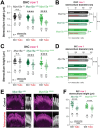Myosin XVA isoforms participate in the mechanotransduction-dependent remodeling of the actin cytoskeleton in auditory stereocilia
- PMID: 39777322
- PMCID: PMC11704364
- DOI: 10.3389/fneur.2024.1482892
Myosin XVA isoforms participate in the mechanotransduction-dependent remodeling of the actin cytoskeleton in auditory stereocilia
Abstract
Auditory hair cells form precise and sensitive staircase-like actin protrusions known as stereocilia. These specialized microvilli detect deflections induced by sound through the activation of mechano-electrical transduction (MET) channels located at their tips. At rest, a small MET channel current results in a constant calcium influx which regulates the morphology of the actin cytoskeleton in the shorter 'transducing' stereocilia. However, the molecular mechanisms involved in this novel type of activity-driven plasticity in the stereocilium cytoskeleton are currently unknown. Here, we tested the contribution of myosin XVA (MYO15A) isoforms, given their known roles in the regulation of stereocilia dimensions during hair bundle development and the maintenance of transducing stereocilia in mature hair cells. We used electron microscopy to evaluate morphological changes in the cytoskeleton of auditory hair cell stereocilia after the pharmacological blockage of resting MET currents in cochlear explants from mice that lacked one or all isoforms of MYO15A. Hair cells lacking functional MYO15A isoforms did not exhibit MET-dependent remodeling in their stereocilia cytoskeleton. In contrast, hair cells lacking only the long isoform of MYO15A exhibited increased MET-dependent stereocilia remodeling, including remodeling in stereocilia from the tallest 'non-transducing' row of the bundle. We conclude that MYO15A isoforms both enable and fine-tune the MET-dependent remodeling of the actin cytoskeleton in transducing stereocilia, while also contributing to the stability of the tallest row.
Keywords: actin cytoskeleton; hair cells; mechanotransduction; myosin XVA; remodeling; stereocilia.
Copyright © 2024 López-Porras, Kruse, McClendon and Vélez-Ortega.
Conflict of interest statement
The authors declare that the research was conducted in the absence of any commercial or financial relationships that could be construed as a potential conflict of interest.
Figures







Update of
-
Myosin XVA isoforms participate in the mechanotransduction-dependent remodeling of the actin cytoskeleton in auditory stereocilia.bioRxiv [Preprint]. 2024 Sep 7:2024.09.04.611210. doi: 10.1101/2024.09.04.611210. bioRxiv. 2024. Update in: Front Neurol. 2024 Dec 23;15:1482892. doi: 10.3389/fneur.2024.1482892. PMID: 39282394 Free PMC article. Updated. Preprint.
Similar articles
-
Myosin XVA isoforms participate in the mechanotransduction-dependent remodeling of the actin cytoskeleton in auditory stereocilia.bioRxiv [Preprint]. 2024 Sep 7:2024.09.04.611210. doi: 10.1101/2024.09.04.611210. bioRxiv. 2024. Update in: Front Neurol. 2024 Dec 23;15:1482892. doi: 10.3389/fneur.2024.1482892. PMID: 39282394 Free PMC article. Updated. Preprint.
-
Myosin-XVa Controls Both Staircase Architecture and Diameter Gradation of Stereocilia Rows in the Auditory Hair Cell Bundles.J Assoc Res Otolaryngol. 2020 Apr;21(2):121-135. doi: 10.1007/s10162-020-00745-4. Epub 2020 Mar 9. J Assoc Res Otolaryngol. 2020. PMID: 32152769 Free PMC article.
-
Auditory mechanotransduction in the absence of functional myosin-XVa.J Physiol. 2006 Nov 1;576(Pt 3):801-8. doi: 10.1113/jphysiol.2006.118547. Epub 2006 Sep 14. J Physiol. 2006. PMID: 16973713 Free PMC article.
-
The actin cytoskeleton in hair bundle development and hearing loss.Hear Res. 2023 Sep 1;436:108817. doi: 10.1016/j.heares.2023.108817. Epub 2023 May 26. Hear Res. 2023. PMID: 37300948 Free PMC article. Review.
-
Building and repairing the stereocilia cytoskeleton in mammalian auditory hair cells.Hear Res. 2019 May;376:47-57. doi: 10.1016/j.heares.2018.12.012. Epub 2019 Jan 2. Hear Res. 2019. PMID: 30638948 Free PMC article. Review.
Cited by
-
Stereocilium height changes can account for the calcium dependence of the outer-hair-cell bundle's resting state.PLoS One. 2025 May 23;20(5):e0314728. doi: 10.1371/journal.pone.0314728. eCollection 2025. PLoS One. 2025. PMID: 40408357 Free PMC article.
References
-
- Shin JB, Longo-Guess CM, Gagnon LH, Saylor KW, Dumont RA, Spinelli KJ, et al. . The R109H variant of fascin-2, a developmentally regulated actin crosslinker in hair-cell stereocilia, underlies early-onset hearing loss of dba/2J mice. J Neurosci. (2010) 30:9683–94. doi: 10.1523/JNEUROSCI.1541-10.2010, PMID: - DOI - PMC - PubMed
Grants and funding
LinkOut - more resources
Full Text Sources
Miscellaneous

